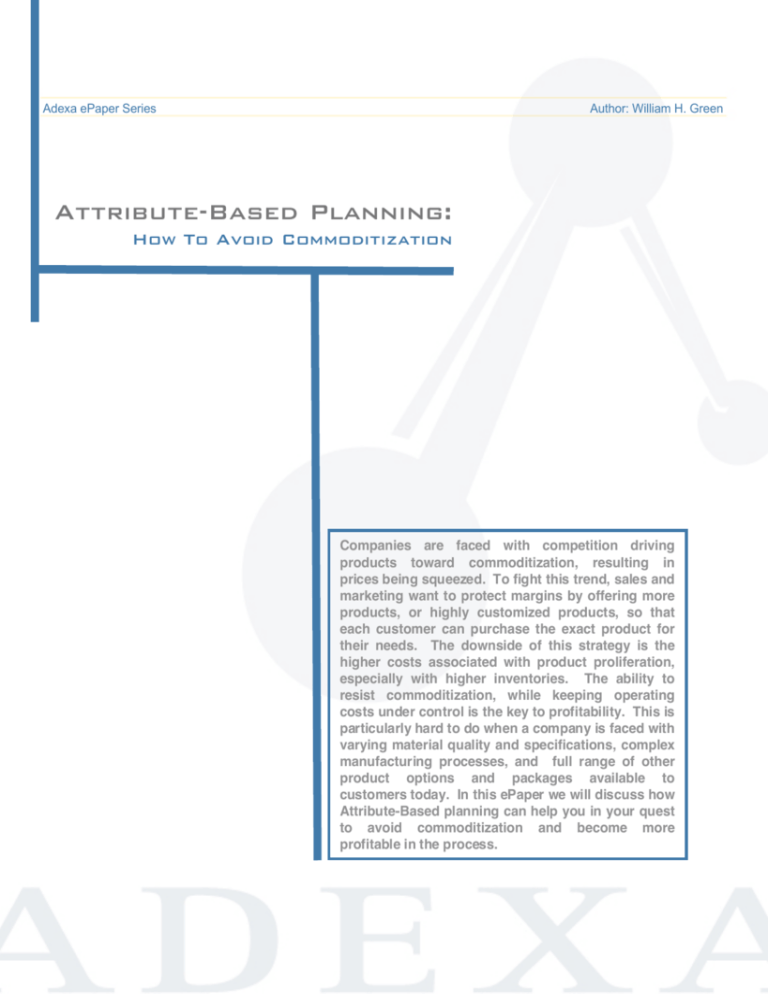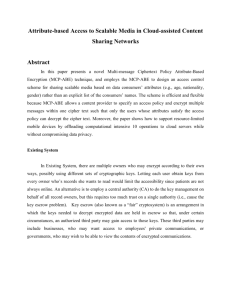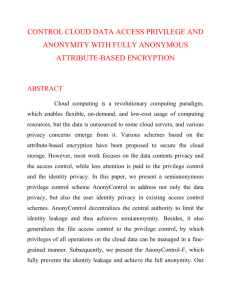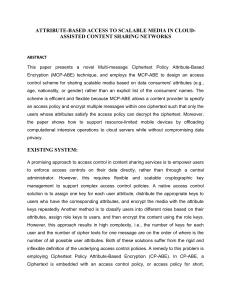
Attribute Based Planning
ePaper /
Adexa
ePaper Series
Common
Pitfalls in Supply Chain System Implementations
Author: William H. Green
Attribute-Based Planning:
How To Avoid Commoditization
Companies are faced with competition driving
products toward commoditization, resulting in
prices being squeezed. To fight this trend, sales and
marketing want to protect margins by offering more
products, or highly customized products, so that
each customer can purchase the exact product for
their needs. The downside of this strategy is the
higher costs associated with product proliferation,
especially with higher inventories. The ability to
resist commoditization, while keeping operating
costs under control is the key to profitability. This is
particularly hard to do when a company is faced with
varying material quality and specifications, complex
manufacturing processes, and full range of other
product options and packages available to
customers today. In this ePaper we will discuss how
Attribute-Based planning can help you in your quest
to avoid commoditization and become more
profitable in the process.
Attribute Based Planning
ePaper / 2
Common Pitfalls in Supply Chain System Implementations
Introduction
Before you read beyond this first sentence, pick which of the diamonds in the picture below you would rather buy
for the same amount of money. Not sure?
Would it help if you knew that both were SKU number DIA8734556 – Pure hard cubic crystalline carbon?
I didn’t think that would help, although this is the way that most companies’ systems, ERP or SCP, are designed
to support their customer needs.
In this case, anyone looking for a diamond wants to know the four C’s (Carat, Color, Clarity, Cut). These are the
attributes of a diamond--perhaps the most famous attributes in the world.
- The diamond on the left is 1.4 carats, clarity – VVS2, color - K, cut - Brilliant (with details in the spec)
- The diamond on the right is 1.2 carats, clarity – VVS1, color - J, cut - Brilliant (with details in the spec)
Beautiful! Aren’t they? However, there still is no clear cut “winner” as to which one to buy, since the first is the
biggest, but the other has better color and clarity. The decision as to which attributes are more important is
dependent on individual needs and preferences of the customer. Is bigger better? Or is color, and fewer flaws,
more important to the person that will be showing off the stone?
What is essential is understanding the needs of the customer, and selling the inventory and capacity in your
supply chain that most closely matches what is important to them, at an appropriate price. This is the best way
to keep your customers happy and protect your margins.
Attribute Based Planning
ePaper / 3
Common Pitfalls in Supply Chain System Implementations
What Is Attribute-Based Planning?
Attributes have traditionally been used as a way to manage the supply chain of products with
complex technical specifications. Besides diamonds, other examples are electrical properties on
high-tech components, and chemical properties on specialty chemicals. These types of products
command higher margins and premium prices because they meet some specific needs of the
customers, and resist the profit-eroding effects of commoditization. More and more businesses are
realizing that Attribute-Based planning should be applied to a much broader range of products than
ever before. This enables an enterprise to charge premium pricing and offer a tailored customer
experience for products that were previously treated as stock items, or were threatened by
commoditization. Companies that have turned to Attribute-Based planning usually increase top-line
sales revenue, and simplify the management of their supply chain to lower operating costs. However,
Offering your customers a tailored experience also adds a whole new level of complexity to your
supply chain that needs to be planned and managed.
Attribute Based Planning
ePaper / 4
Common Pitfalls in Supply Chain System Implementations
Why Attribute-Based Planning?
It is a well know fact that commoditization of a product destroys the ability to hold premium pricing. A
product with no differentiation in the market will be compared on a one-to-one basis with its
competition, and the winner will be selected on price alone. Product differentiation helps to raise
selling prices, and Attribute-Based product management would allow a company to differentiate their
products. The secret of how Attribute-Based supply chain planning allows a company to increase
revenue is very simple. Highlight the hidden value (i.e. attributes) of what you produce, and sell it to a
customer that needs those attributes, charging them a premium price. For those customers that do
not care, sell the units containing characteristics that other customers do not value, at a non-premium
price.
Lets look at examples of some important attributes by
industry. In the semiconductor industry: speed of the
die. The faster die command the higher prices. In
Steel industry: width, grade, length.
In textiles
Industry: color, texture, finish. In Chemical Industry:
fluidity and consistency. In CPG: Manufacture-Date.
And I am sure there are many other ways that
customers may feel that they can gain advantage by
having specific attributes on the product. Can you
think of some attributes, right now, to better meet your
customer needs, and keep commoditization at bay?
Here is an easy way to get started…
Attribute Based Planning
ePaper / 5
Common Pitfalls in Supply Chain System Implementations
Get Started
The first step for advancing the use of attributes is to identify the attributes that are required to provide
a technically acceptable product, a premium product, or a customized product to your customer. This
may be done to satisfy the engineering specification for a product, or in turn offer your customer
something to sell that differentiates them from their competitors.
For quality and consistency purposes for the customer the attributes can be used to specify the raw
materials used in the product, like the location of manufacture, or the method and resource used. All
these things can command premium charges. Why give away products made on your most expensive
machines, at no extra charge? Examples of this are companies using qualification matrices for
manufacturing location and raw material identifiers to track the type, origin, or properties of materials
used to make products.
The next step is to put in place a process of using the attributes to provide a premium experience
while selling. This occurs while negotiating contracts, collaborating over forecasts during the salesand-operations (S&OP) plan, and when a customer is placing the order. With Attribute-Based S&OP
Planning, attributes can be used to differentiate the available product into finer categories. This
product availability statement along with the associated target pricing which utilizes attributes can be
used to create an S&OP plan that will generate the most revenue. A S&OP planning process without
the use of attributes can not keep track of what segments of the expected product supply will be
available for premium pricing.
At order entry time, attributes can be used to find the right units of products to meet the customers
immediate need. Attribute-Based Available-to-promise (ATP) and Attribute-Based Vendor Managed
Inventory is the process of using attributes to match your customers specific needs with your
available product supply. With Attribute-Based ATP, customer service representatives offer
suggestions as to what alternatives are available in case a preferred configuration is not available as
requested and/nor on-time. Thus, if the customer desired a lower grade product, the response from
your representative could be: “based on availability of material and capacity, this can be delivered in 6
weeks or a higher grade product can be delivered in three days.” Attributes are essential to making
this work.
Attribute Based Planning
ePaper / 6
Common Pitfalls in Supply Chain System Implementations
Is the Complexity Worth It?
In order to get premium pricing and provide highly-tailored customer service, the strategy of product
attributes adds complexity to the enterprise. For example, instead of just taking any inventory item
from stock, we are going to offer the units that most fit a customers needs. Instead of producing
goods on a resource of our choosing, or a process that is most available, we are providing a premium
option to choose where a product is made, to insure consistent quality. This is the exact opposite of
the product rationalization efforts that companies utilize in order to simplify and lower costs. But in
turn, you can use Attribute-Based Planning to lower the cost of operations. In effect Attribute-Based
Planning breaks the traditional trade off between product proliferation and added operations cost.
This is done in a number of ways.
First, a company must move from traditional item-master
management to a product-master.
This is because
traditional item-masters can not handle the combinatorialexplosive nature of the alternative choices. In order to offer
a customer the exact units of inventory that they may want,
a company may need to track many different attributes.
One example is high tech component manufacturer. A
typical need in this industry would be for 7 to 12 attributes
with an average of 10 choices for each attribute to fully
describe the product to customers (Example are: memory
size, alternate components, speed designation, place of
manufacture, and package type). If traditional or smart part
numbers were used for master data management, between
10 million and 1 trillion part numbers would be needed.
Thus, cost on data maintenance, software complexity, and
hardware required is enormous. Instead a company can
manage with just 7 to 10 attributes. The only data that is
required is what attributes a customer wants with each
order. The rest should be handled by the Attribute-Based
logic in your planning system.
Second, attributes can also significantly increase a companys ability to manage finished-goods and
intermediate inventory, so that higher service levels can be achieved at lower inventory levels.
Attributes allow a company to look at inventory as different pools of similar items that can be managed
against customer orders and manufacturing requirements. This logical inventory pooling helps to hold
down the natural fluctuations in demand and allow inventory managers get the most out of the
available supply. The ability to allow a system to analyze targeted demands against specific available
supply and perform rebalancing of supply vs. demand is what makes Attribute-Based inventory
management very efficient.
Attribute Based Planning
ePaper / 7
Common Pitfalls in Supply Chain System Implementations
Attributes Apply To The Entire Supply Chain
Production costs in the supply chain can be lowered through Attribute-Based supply planning.
Attributes on demand (i.e. customer orders) describe the request for premium production services
(e.g. preferred location, process, or resources) that have been promised to a customer. These
requests can be propagated through the supply chain planning process so that where choices are
available, the appropriate selection for location, or production, process can be made. The userattributes and costs will allow production planning to make sure that a customer gets what they
have paid for, and the company can save by selecting lower cost alternatives when no preference
has been purchased.
In the same way that resource and location, choices are facilitated, materials management can
be enabled with attributes. As an example, a company may purchase an environmentally friendly
product at a premium price. Attributes can be used to show this preference on the customer
order, which commands extra charges. If there is no designation on the order regarding this, then
lower cost materials could be used. Another way that materials can be managed with attributes is
to manage materials for consistent engineering specifications on the delivered item. If a company
charges a premium price for a specific engineering tolerance on a part, it may be necessary to
control the specifications of the materials that go into the product to a tighter range. Attributes
can be used to only select the materials that will hold to this more limited engineering
specification during a manufacturing process. Once again, these materials should only be used if
the customer is paying a premium price.
In summary the use of Attribute-Based planning allows a company to manage the complete
supply chain in alignment with the premiums that a customer has paid to receive. This includes
managing inventory, production, distribution, or materials. Attribute-Based planning is not only an
enabler for protecting your margins, but it is also a way for a company to manage costs. It is the
way to enforce: “You get what you pay for”.
Attribute Based Planning
ePaper / 8
Common Pitfalls in Supply Chain System Implementations
Why does my current system come up short?
Over thirty years ago when computers had less power than your common TV set, MRP systems
came up with the data model architecture that starts with an item-master and the SKU-number. This
same design has been kept through the evolution of MRP into ERP systems, and was copied by
almost all enterprise planning systems that are in use today. This item-master and SKU-number data
model is the very core reason of why these systems are not able to effectively deal with attributes.
The problem is that you have to give every possible combination an SKU-number to differentiate it.
You can see how difficult that can be if you do the math. Lets take the following example:
1000 products x 10 grades x 30 speeds x 10 locations = 3 million combinations of products
If a 100 customers want a little something different on each product = 300 million combinations
If they want to track the 4 possible manufacturing location = 1.2 Billion combinations
And if they want to track the 3 possible material sources for just one component in the product
then you have =
3,600,000,000 combinations!
Now Its easy to see why traditional systems fail when you are trying to plan and commit to your
customers with this kind of mind-boggling number of product combinations.
ePaper / 9
Attribute Based Planning
Common Pitfalls in Supply Chain System Implementations
Traditional Systems Hurt Profitability
A Traditional system that does not utilize native Attribute-Based planning capabilities tends to
negatively impact customer service levels, and drive excess inventory. Why? Such a system can
not accurately determine if there is enough inventory on-hand to meet an order--it will either over
promise, or requires extra inventory to cover up the problems. This says nothing about the ability
to source to a certain manufacturing location properly, selecting material from an approved
vendors list, or meet any of the many other preferences that a customer may have.
A simple example can highlight typical issues with a traditional planning system, lacking AttributeBased capabilities:
Table 1 shows a sample order (D1) for a product, with customer-requested attribute Q1, entered
into the order entry system,. Table 2 shows a typical supply-statement from a traditional planning
system. Without attributes, this system will quote availability date of 1/12 to the customer. Note
that the ERP warehouse system has the attribute information, but the planning system can not
support it. On the other hand, Table 3 shows a supply-statement from a planning system with
attributes, which clearly indicates the availability date of 1/18.
The damage to the company from this very common problem is real and felt at the bottom-line.
Usually a company will compensate with extra inventory to avoid the problem. There are many
other examples of such problems that are similar in nature, including not knowing if the specified
materials are on hand, not sure if the capacity load on a plant is accurate, or not sure if a specific
resources is overloaded in a plant. If you can not see it you can not plan it.
Table 1 – Customer Order
Table 2 - No attributes
Table 3 – with attributes
Attribute Based Planning
ePaper /10
Common Pitfalls in Supply Chain System Implementations
An Ideal Attribute-Based Planning System
An ideal planning system should include the ability to handle Attribute-Based master-data, planning
data and business logic. Naturally, the system needs to be flexible enough to be able to define
attributes though out the entire supply chain processes, at any level. This includes orders, itemmasters, supply, inventory, manufacturing processes, routes, resources, BOMs, etc. This is so that
you can flexibly represent your products and packages. To that end, the system must accept an
unlimited number of attributes defined by the users as they are added, edited, updated, and
deleted—quickly and at low cost. The ability to define attributes without having to go back to a
centralized group of programmers, or the IT department, is critical. Additionally, attributes must be
part of the core data model and planning algorithms of the system, while accommodating special
business rules on-the-fly. Otherwise the system wont be nearly powerful or fast enough to handle the
choices that you want to give customers.
Bottom line, make sure you do your homework when it comes
to a planning system. Insist on a demo with some of your
prototype data in it. Note how easy it is to change your
attributes and related business rules. Pay attention to the
depth and breadth of data that the system propagates back
into your supply chain processes. Preferably, you want to see
a connection from your customer orders, all the way back to
your supplier purchase orders. And dont forget, speed is a
huge factor. You want answers for your customer in seconds,
not hours—specially when you are committing an order.
Attribute Based Planning
ePaper /11
Common Pitfalls in Supply Chain System Implementations
Conclusion
The need to differentiate products and give your customers a unique offering is critical to avoid
commoditization. This is driving more and more companies to manage products with attributes. Most
companies that do not move down this path are probably giving away hidden value in their products for
free, or not putting forth the kind of customer experience that they are truly capable of providing. In
order to manage the complexity that attributes brings to the supply chain, software specifically designed
to handle Attribute-Based planning is required. And remember, you can treat your products like
Diamonds, too!
ePaper /12
Attribute Based Planning
Common Pitfalls in Supply Chain System Implementations
About the Author:
William H. Green is Adexa's Vice President of Solutions, overseeing the
company's Product Management Group and Solutions Support Center. With
extensive application and technical expertise, he has implemented supply chain
solutions for companies in multiple industries, including consumer package
goods, chemical, high-tech and semiconductor. Prior to joining Adexa in 1997,
William spent eight years at Numetrix; prior to that, he worked in A&D industry,
at Grumman Aircraft and Boeing Commercial Aircraft.
Contact: wgreen@adexa.com
Resources:
Click here For:
Supply Chain Planning Blog
Click here For:
Planning Systems
Click here For:
Click here For:
Questions
Adexa
Please feel free to post this on your blog
or email it to whomever you believe
would benefit from it. Thank You.
U.S. © 2010 Adexa, Inc. All rights reserved.
Version A.1








